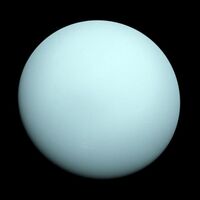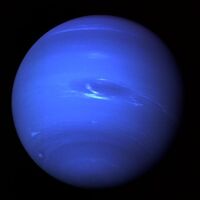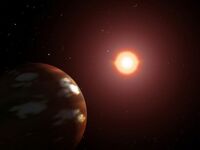


Gliese 436 b (Nemea), created by an artist
Midplanet, also known as hyper-Earth, hypo-Jupiter, or neptunian planet, is a classification of planet with mass ranging from 10 to 31.8 Earth masses or 0.0315 to 0.1 Jupiter masses. Hence it is the fourth most massive mass class of planet, super-Earth is rated M-Class IV and has the symbol N.
Characteristics[]
Many midplanets have icy or liquid interiors with thick gaseous envelope (atmosphere) with large rocky core. Ocean planets with oceans often thousands of miles deep would be a common property of close-orbiting midplanets. Even some lower-mass midplanets have rocky surface with thick blanket of hydrogen-helium gas, if they have enough rocky material.
Habitability[]
The habitability for life on midplanets depend on if this planet is gaseous, oceanous or rocky. If it is a gaseous planet, then it is unlikely to have life unless if aerial life somehow form and evolve. If it is an ocean planet, then life can easily form and evolve in water or other liquid. If its rocky, its hard to form and evolve since the gravity is so strong.
Abundance[]
There are an estimated 123 billion midplanets in our galaxy alone, making it the fourth most abundant mass class of planet after mid-Earth, sub-Earth, and super-Earth. This corresponds that 150‰ of all 820 billion planets in our galaxy are midplanets.
Known midplanets[]
Over 500 known midplanets have been discovered as of 2015. Uranus (Sol h, P7, 14.5 M⊕) and Neptune (Sol i, P8, 17.1 M⊕) are obviously the first midplanets discovered since these planet are located in our solar system. In 2004, the first extrasolar midplanet discovered was Mu Arae d (Peucetis), roughly two and a quarter centuries after the first midplanet was discovered (Uranus in 1781). Other notable examples of extrasolar midplanets are Gliese 436 b (Nemea), also among the first, all three planets in the 99 Puppis system (Lachesis, Atropos, and Clotho), and the habitable zone planet Gliese 370 b (Mors).
Related links[]
| ||||||||||||||